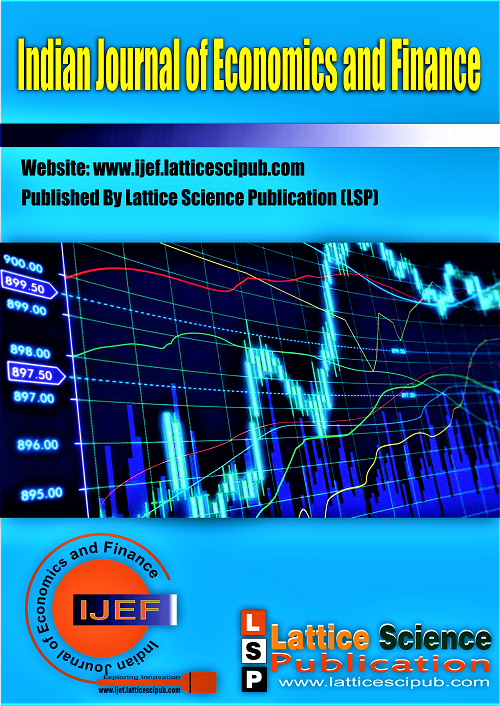The Impact of Advanced Economy Monetary Policy on Gold Price Dynamics in India
Main Article Content
Abstract
Gold remains a dynamic investment tool in many economies and is considered a safe- haven during times of crises. The sheer size of the US economy and hence any monetary policy decisions have implications for the global economy and global assets. Since commodities are priced in the US dollar, transmission of shocks to asset prices is bound to happen as investors rebalance portfolio. Now, the direction of movement in gold prices depends on other factors as well. Against this backdrop, we examine the impact of US monetary policy on gold prices in India and try to examine how monetary policy announcements during the pandemic by the Fed has influenced domestic gold prices. Further, we investigate the determinants of domestic gold prices using an ARDL model and find that prices have moved closely with global economic policy uncertainty, thereby demonstrating its safe haven feature and have risen with domestic CPI inflation, thus proving to be an inflation hedge. Thus, the study is expected to upgrade the understanding on the behaviour of investors towards gold, and information processing under uncertainty. JEL Classification: G10, G15.
Downloads
Article Details

This work is licensed under a Creative Commons Attribution-NonCommercial-NoDerivatives 4.0 International License.
How to Cite
References
Adrangi, B., Chatrath, A., & Raffiee, K. (2003). Economic Activity, Inflation and Hedging: The Case of Gold and Silver Investments, The
Journal of Wealth Management. [CrossRef]
Bernanke, B.S., & Kuttner, K.N. (2005). What Explains the Stock Market's Reaction to Federal Reserve Policy? The Journal of Finance, American Finance Association, May. [CrossRef]
Fergal A. O'Connor, Brian M. Lucey, Jonathan A. Batten, Dirk G. Baur (2015). "The financial economics of gold — A survey", International
Review of Financial Analysis. [CrossRef]
Fortune, J. N. (1987). The Inflation Rate of the Price of Gold, Expected Prices and Interest Rates. Journal of Macroeconomics. [CrossRef]
Frankel, J.A. (1984). Commodity Prices and Money: Lessons from International Finance. American Journal of Agricultural Economics.
[CrossRef]
Frankel, J. A., & Rose, A. K. (2010). Determinants of Agricultural and Mineral Commodity Prices. HKS Faculty Research Working Paper Series.
Jiang, Y., & Wang, G. (2017). Monetary Policy Surprises and the Responses of Asset Prices: An Event Study Analysis. SSRN, July. [CrossRef]
Karunakaran, Girish., Choudhary, Nidhi., & Purohit, Harsh. (2015). The Relationship Between Gold Prices and Exhange Value of US Dollar in India. Emerging Markets Journal. Vol.5. [CrossRef]
Lawrence, C. (2003). Why is Gold different from other Assets? An Empirical Investigation. World Gold Council, March.
Levin, E.J., Montagnoli, A. & Wright, R.E. (2006). Short-run and Long-run Determinants of the Price of Gold. World Gold Council. Research Study No. 32.
Moore, G.H., & Geoffrey H. (1990). Gold Prices and a Leading Index of Inflation. Economics and Business Studies, Vol. 33. [CrossRef]
Samveg, Patel. (2013). Causal Relationship Between Stock Market Indices and Gold Price: Evidence from India. The IUP Journal of Applied Finance, Vol. 19, January.
Sherman, E. J. (1983). A Gold Pricing Model. The Journal of Portfolio anagement. [CrossRef]
Silva, E. S. (2014). Forecasting the Price of Gold, Atlantic Economic Journal.
Soumya Sharma (2018). Determinants of gold prices in India, doi:10.17010/ijf/2020/v14i2/150554. [CrossRef]
World Gold Council (2019). Investment Update: The impact of monetary policy on gold, March.
Worthington, A. C., & Pahlavani, M. (2007). Gold Investment as an Inflationary Hedge: Cointegration Evidence with allowance for Endogenous Structural Breaks. Applied Financial Economics Letters. [CrossRef]
Zhu, Y., Fan, J. & Tucker, J. (2018). The impact of monetary policy on gold price dynamics. Research in International Business and Finance,
April. [CrossRef]





